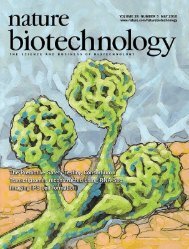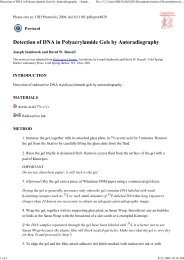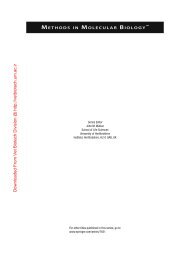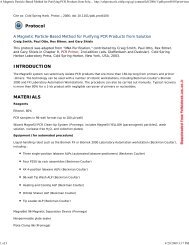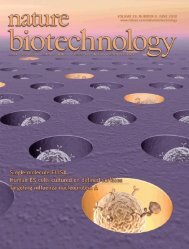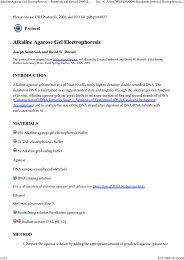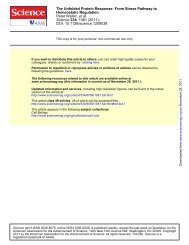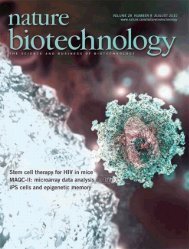correspondence© 2010 Nature America, Inc. All rights reserved.Table 1 IgG4 monoclonals that have been in trials or on the marketCompany (location)Antibody (brand name)Stabilizedhinge a Type Target StageWyeth (Madison, NJ, USA) UCB (Brussels) Gemtuzumab (Mylotarg) YES Humanized CD33 MarketBiogen-Idec (Cambridge, MA, USA), Elan (Dublin) Natalizumab (Tysabri) NO Humanized VLA-4 (CD49d) MarketBiogen-Idec, UCB CDP 571 (Humicade) No Humanized Tumor necrosis factor alpha(TNFalpha)AstraZeneca (London) with Medimmune-CambridgeAntibody Technology (CAT) (Gaithersburg, MD, USA)PDL Biopharma (Redwood City, CA, USA)with Biogen-IdecCAT-152/lerdelimumab N/A Human Transforming growth factor(TGF)-beta 2Volociximab N/A Chimeric α5β1 integrin Phase 2Discontinued afterphase 3Discontinued afterphase 3Bristol Myers Squibb (Princeton, NJ, USA) BMS-663513 N/A Human CD137 (4-1BB) Phase 2Genzyme (Cambridge, MA, USA) with AstraZeneca GC-1008 N/A Human TGF-beta (1,2,3) Phase 2(Medimmune-CAT)Tanox (Houston) with Biogen-Idec TNX-355/ibalizumab No Humanized CD4 Phase 2AstraZeneca (Medimmune-CAT) CAT-354 No Human Interleukin 13 Phase 2iCo Therapeutics (Vancouver, BC, Canada) with iCo-008/CAT 213)/bertilimumab No Human Eotaxin Phase 2Medimmune-CATAltor Bioscience (Palm Beach, FL, USA) with Tanox ALT-836/TNX-832 N/A Chimeric Tissue factor Phase 2bBiogen-Idec IDEC-151/clenoliximab YES Chimeric CD4 Discontinued afterphase 2Genzyme, AstraZeneca (Medimmune-CAT) CAT-192/metelimumab No Human TGF-beta 1 Discontinued afterphase 2Biotest (Dreieich, Germany) BT-062 N/A Humanized Syndecan-1 (CD138) Phase 1Innate Pharma (Marseille, France) IPH 2101 Yes Human Natural killer inhibitory Phase 1receptorHuman Genome Science (Rockville, MD, USA)/ HGS-TR2J No Human TNF-related apoptosisinducingPhase 1Kirin (Tokyo)ligand receptor 2(TRAIL-2R)Human Genome Science HGS004 No Human CC-motif chemokine Phase 1receptor 5 (CCR5)PanGenetics PG102 NO Humanized CD40 Phase 1PanGenetics ch5D12 NO Chimeric CD40 Phase 1Johnson & Johnson (New Brunswick, NJ, USA) hOKT3γ4 N/A Humanized CD3 Discontinued afterphase 1GPC Biotech (Martinsreid, Germany) 1D09C3 No Human Human leukocyte antigen(HLA)-DRTeGenero Immuno Therapeutics(now closed; Wurzburg, Germany)a Uppercase data (YES/NO) confirmed; sentence case data (Yes/No) based on patent/literature information; N/A, not available.Discontinued afterphase 1TGN1412 NO Humanized CD28 Discontinued afterphase 1state and the tropism of the virus for(pre-)B cells and CD34 + hematopoieticprogenitor cells (reviewed in ref. 10). So inthe event that JCV-VLA4 bispecifics wereto be circulating in natalizumab-treatedpatients, the chance that these bispecificswould indeed mediate capture of free virusparticles would be vanishingly low. Lastly,Labrijn et al. 1 postulate that JCV, capturedby JCV-VLA4 bispecifics, is transported intothe CNS by infiltrating activated (VLA4 + )leukocytes. This last step would requirean active infiltration of leukocytes intothe CNS of natalizumab-treated patients.Although the influx of leukocytes intoareas of disease activity is a pathologicalhallmark of MS, it is exactly this featurethat is inhibited by natalizumab. Numerousstudies, including both animal and humandata, have demonstrated that antibodiesagainst α4-integrins effectively prevent theaccumulation of leukocytes in the CNS. Morespecifically, it has been demonstrated thatcompared with patients with MS not treatedwith natalizumab, cerebrospinal fluid fromnatalizumab-treated patients has significantlyfewer white blood cells, CD4 + T cells, CD8 +T cells, CD19 + B cells and CD138 + plasmacells. These levels remain low, even 6 monthsafter cessation of natalizumab (reviewed inref. 11).On the basis of the above evidence, weconclude the following: first, JCV-VLA4bispecifics in natalizumab-treated patientshave not been demonstrated and, if theywere to exist, would be transient; second, thechance for JCV-VLA4 bispecifics to capturefree virus particles is infinitesimal; andthird, any facilitation of transport of JCVby activated leukocytes is prevented by anoverall natalizumab-mediated inhibition ofleukocyte entry into the CNS.We wish to emphasize that it is wellknownthat PML tends to arise inchronically immunosuppressed patients.CD4 + and CD8 + T lymphopenia resultingfrom HIV infection, chemotherapy orimmunosuppressive therapy are the primaryrisk factors. In addition to the cases reportedfor natalizumab treatment, PML has beenreported to occur in patients treated withIgG1-based biologicals, including rituximab(Rituxan), efalizumab (Raptiva) andalemtuzumab (Campath) 10,12,13 .Furthermore, we would like to point outthat Labrijn et al. 1 fail to explain how Fabarmexchange might have caused cytokinestorm in TGN1412-treated patients. However,the authors do prominently mention thatthe kinetics of these adverse events are124 volume 28 number 2 february 2010 nature biotechnology
correspondence© 2010 Nature America, Inc. All rights reserved.compatible with the first detection of Fabarmexchange in their study. We wish to stressthat none of the many papers publishedthat studied the mechanism for TGN1412-associated cytokine storm consider Fab-armexchange. In contrast, almost all point tospecific CD28 target biology (e.g., see refs.14,15).Although we acknowledge that a Lettercan have room for some speculation, therepeated insinuated link between Fab-armexchange and adverse events to natalizumaband TGN1412 is misleading. We believe thatFab-arm exchange poses no generic safetyissue but recognize that a major disadvantagewill be the unpredictability for humanimmunotherapy due to the dynamics ofthe transient existence of specific Fab-armcombinations and reduced ability to crosslinkthe originally targeted antigen.The absence of any generic safety issue issupported by the number of independentclinical studies performed with monoclonalIgG4 to date (Table 1). We fear that,through repetition, the notion that Fab-armswitching causes adverse events will becomeaccepted, which will undermine the effortsof biopharmaceutical companies developingwild-type IgG4 candidate drugs. This concernis substantiated by the observation that, sincethe publication of the previously mentionedPerspectives article by Burton and Wilson 5 ,the alleged link between Fab-arm exchangeand adverse events to wild-type IgG4 didreach biotechnology stakeholders. Onebiopharmaceutical company announcedthe discontinuation of its antibody programmentioning the “General concerns ofFab-arm exchange,” although the drugcandidate had not raised any unexpectedor unacceptable safety concerns in initialclinical testing (Supplementary Note).On top of that, the Distillery section ofthe newsletter SciBX 16 , which each weeksummarizes the most essential scientificfindings in techniques of commercial interest,summarizes Labrijn et al. 1 by reciting “Fabarmexchange occurs when the arm fragmentof a therapeutic antibody exchanges withthe arm fragment of an endogenous plasmaantibody. The result is a bispecific antibodythat reduces the binding affinity of thetherapeutic antibody and potentially leadsto side effects such as progressive multifocalleukoencephalopathy (PML).” A later issueof SciBX 17 amplified this summary. Thisdemonstrates that reinforcement of theunfounded assertion has already begun.In conclusion, we are not aware of anyevidence or theory to support a generic safetyissue for Fab-arm switching and would like toalert the antibody community on misleading‘arm-waving’.Note: Supplementary information is available on theNature Biotechnology website.COMPETING INTERESTS STATEMENTThe authors declare competing financialinterests: details accompany the full-text HTMLversion of the paper at http://www.nature.com/naturebiotechnology/.Ellen Broug 1 , Philip A Bland-Ward 2 ,John Powell 2 & Kevin S Johnson 21 PanGenetics BV, Utrecht, The Netherlands.2 PanGenetics BV, Royston, United Kingdom.email: ellen.broug@pangenetics.com1. Labrijn, A.F. et al. Nat. Biotechnol. 27, 767–771(2009).2. van der Neut Kolfschoten, M. et al. Science 317,1554–1557 (2007).3. Schuurman, J. et al. Immunology 97, 693–698(1999).4. Aalberse, R.C. & Schuurman, J. Immunology 105,9–19 (2002).5. Burton, D.R. & Wilson, I.A. Science 317, 1507–1508(2007).6. Suntharalingam, G. et al. N. Engl. J. Med. 355, 1018–1028 (2006).7. Kleinschmidt-DeMasters, B.K. & Tyler, K.L. N. Engl. J.Med. 353, 369–374 (2005).8. Egli, A. et al. J. Infect. Dis. 199, 837–846 (2009).9. Iacobaeus, E. et al. Mult. Scler. 15, 28–35 (2009).10. Carson, K.R. et al. Lancet Oncol. 10, 816–824(2009).11. Stüve, O. et al. J. Neurol. 255 suppl.6, 58–65(2008).12. Carson, K.R. et al. Blood 113, 4834–4840 (2009).13. Waggoner, J., Martinu, T. & Palmer, S.M. et al. J. HeartLung Transplant. 28, 395–398 (2009).14. Schraven, B. & Kalinke, U. Immunity 28, 591–595(2008).15. Gogishvili, T. et al. PLoS ONE 4, e4643 (2009).16. Anonymous. SciBX 2, doi:10.1038/scibx.2009.1195.17. Edelson, S. SciBX 2, doi:10.1038/scibx.2009.1231.Labrijn et al. reply:Our papers test the hypothesis of IgG4 Fabarmexchange 1,2 . In a series of in vitro andin vivo experiments, we provide convincingexperimental evidence for the occurrenceof Fab-arm exchange and show that thismechanism represents an intrinsic activityof IgG4 antibodies that affects treatmentwith IgG4-based therapeutics in patients.Broug et al. criticize our approach andsuggest that we are reiterating previousinsights. Surely, however, Broug et al.understand that we are employing the timehonoredapproach of hypothesis-drivenresearch. Thus, a hypothesis should notbe accepted until rigorous testing showsit to be true, which then leads to novelhypotheses. IgG4 Fab-arm exchange therebyhas only recently become scientific fact 1,2 .The hypothesis that states that Fab-armexchange of therapeutically administeredand endogenous IgG4 molecules maygenerate bispecific IgG4 with undesiredspecificity that induce adverse events 3still requires (clinical) testing. Brouget al. specifically object to a discussionin which we visit the idea that Fab-armexchange of natalizumab with patientIgG4 might play a role in the pathogenesisof PML 2 . Examining this notion, wedraw the conclusion (albeit not veryplausible under normal conditions)that our analysis cannot fully excludethe possibility that cross-linking undercertain (pathological) conditions may besufficient for undesired biological effects.This limitation, however, also applies tothe discussion brought forward by Brouget al., despite their comprehensive citing ofliterature. We fully acknowledge the absenceof reported evidence for generic safetyissues with IgG4 molecules and do notclaim that natalizumab is ‘unsafe’. As ourpharmacokinetic modeling already suggests,the frequency of IgG4 with undesiredcross-linking ability is probably very low 1 .Studies with large patient populations willbe required to investigate their presenceand effect. In the case of natalizumab,the potential safety-risk, furthermore,has already been mitigated by extensivescreening for JCV.Does our research undermine efforts ofbiopharmaceutical companies developingwild-type IgG4 candidate drugs, asargued by Broug et al.? The mechanismof Fab-arm exchange, in our view, makesthe development of nonstabilized IgG4antibody therapeutics highly problematicas it complicates manufacturing,affects pharmacokinetics and makespharmacodynamics unpredictable. Thelast of these problems is brought homeby observations with the therapeuticIgG4 anti-HLA DR antibody 1D09C3,which was not discontinued because ofunsubstantiated concerns, as suggestedby Broug et al., but instead was foundto become inactive following Fab-armexchange 4 . With the demise of 1D09C3, itcan be learned from Table 1 in Broug et al.that Pangenetics’ CD40 antibodies ch5D12and PG102 remain the only two confirmednonstabilized IgG4 antibodies in clinicaldevelopment. Biotechnology companies,of course, are responsible for plotting theirown strategy. Nevertheless, as discussedby De Rubertis et al., successful companiesshould combine strong science with acapability to absorb failure, adapt and moveon 5 .It can certainly be argued that theimpact of the unpredictable behavior ofnonstabilized, wild-type, IgG4 antibodiesin terms of manufacturing, consistency,nature biotechnology volume 28 number 2 february 2010 125
- Page 3 and 4: volume 28 number 2 february 2010COM
- Page 5 and 6: in this issue© 2010 Nature America
- Page 7 and 8: © 2010 Nature America, Inc. All ri
- Page 10 and 11: NEWS© 2010 Nature America, Inc. Al
- Page 12 and 13: NEWS© 2010 Nature America, Inc. Al
- Page 14 and 15: NEWS© 2010 Nature America, Inc. Al
- Page 16 and 17: © 2010 Nature America, Inc. All ri
- Page 18 and 19: © 2010 Nature America, Inc. All ri
- Page 20 and 21: © 2010 Nature America, Inc. All ri
- Page 22 and 23: NEWS feature© 2010 Nature America,
- Page 24 and 25: uilding a businessComing to termsDa
- Page 26 and 27: uilding a business© 2010 Nature Am
- Page 30 and 31: correspondence© 2010 Nature Americ
- Page 32 and 33: correspondence© 2010 Nature Americ
- Page 34 and 35: correspondence© 2010 Nature Americ
- Page 36 and 37: case studyNever againcommentaryChri
- Page 38 and 39: COMMENTARY© 2010 Nature America, I
- Page 40 and 41: COMMENTARY© 2010 Nature America, I
- Page 42 and 43: patents© 2010 Nature America, Inc.
- Page 44 and 45: patents© 2010 Nature America, Inc.
- Page 46 and 47: news and viewsChIPs and regulatory
- Page 48 and 49: news and viewsFrom genomics to crop
- Page 50 and 51: news and views© 2010 Nature Americ
- Page 52 and 53: news and views© 2010 Nature Americ
- Page 54 and 55: e s o u r c eRational association o
- Page 56 and 57: e s o u r c e© 2010 Nature America
- Page 58 and 59: e s o u r c e© 2010 Nature America
- Page 60 and 61: e s o u r c e© 2010 Nature America
- Page 62 and 63: © 2010 Nature America, Inc. All ri
- Page 64 and 65: B r i e f c o m m u n i c at i o n
- Page 66 and 67: i e f c o m m u n i c at i o n sAUT
- Page 68 and 69: lettersa1.5 kb hVPrIntron 112.5 kbA
- Page 70 and 71: letters© 2010 Nature America, Inc.
- Page 72 and 73: letters© 2010 Nature America, Inc.
- Page 74 and 75: l e t t e r sReal-time imaging of h
- Page 76 and 77: l e t t e r sFigure 2 Time-lapse li
- Page 78 and 79:
l e t t e r s© 2010 Nature America
- Page 80 and 81:
l e t t e r sRational design of cat
- Page 82 and 83:
l e t t e r s© 2010 Nature America
- Page 84 and 85:
l e t t e r s© 2010 Nature America
- Page 86 and 87:
sample fluorescence was measured as
- Page 88 and 89:
careers and recruitmentFourth quart




